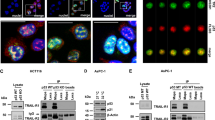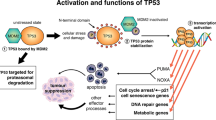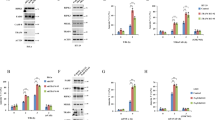Abstract
Tumour necrosis factor receptor (TNFR)-associated death domain (TRADD) protein is a central adaptor in the TNFR1 signalling complex that mediates both cell death and inflammatory signals. Here, we report that Tradd deficiency in mice accelerated tumour formation in a chemical-induced carcinogenesis model independently of TNFR1 signalling. In vitro, primary cells lacking TRADD were less susceptible to HRas-induced senescence and showed a reduced level of accumulation of the p19Arf tumour suppressor protein. Our data indicate that TRADD shuttles dynamically from the cytoplasm into the nucleus to modulate the interaction between p19Arf and its E3 ubiquitin ligase ULF, thereby promoting p19Arf protein stability and tumour suppression. These results reveal a previously unknown tumour-suppressive role for nuclear TRADD, augmenting its long-established cytoplasmic functions in inflammatory and immune signalling cascades. Our findings also make an important contribution to the rapidly expanding field of p19Arf post-translational regulation.
This is a preview of subscription content, access via your institution
Access options
Subscribe to this journal
Receive 12 print issues and online access
$209.00 per year
only $17.42 per issue
Buy this article
- Purchase on Springer Link
- Instant access to full article PDF
Prices may be subject to local taxes which are calculated during checkout






Similar content being viewed by others
References
Hanahan, D. & Weinberg, R. A. Hallmarks of cancer: the next generation. Cell 144, 646–674 (2011).
Bos, J. L. Ras oncogenes in human cancer: a review. Cancer Res. 49, 4682–4689 (1989).
Serrano, M., Lin, A. W., McCurrach, M. E., Beach, D. & Lowe, S. W. Oncogenic ras provokes premature cell senescence associated with accumulation of p53 and p16INK4a. Cell 88, 593–602 (1997).
Sherr, C. J. & Weber, J. D. The ARF/p53 pathway. Curr. Opin. Genet. Dev. 10, 94–98 (2000).
Palmero, I., Pantoja, C. & Serrano, M. p19ARF links the tumour suppressor p53 to Ras. Nature 395, 125–126 (1998).
Pomerantz, J. et al. The Ink4a tumor suppressor gene product, p19Arf,interacts with MDM2 and neutralizes MDM2’s inhibition of p53. Cell 92, 713–723 (1998).
Chen, D. et al. ARF-BP1/Mule is a critical mediator of the ARF tumor suppressor. Cell 121, 1071–1083 (2005).
Kuo, M. L., den Besten, W., Bertwistle, D., Roussel, M. F. & Sherr, C. J. N-terminal polyubiquitination and degradation of the Arf tumor suppressor. Genes Dev. 18, 1862–1874 (2004).
Bertwistle, D., Sugimoto, M. & Sherr, C. J. Physical and functional interactions of the Arf tumor suppressor protein with nucleophosmin/B23. Mol. Cell Biol. 24, 985–996 (2004).
Pollice, A., Vivo, M. & La Mantia, G. The promiscuity of ARF interactions with the proteasome. FEBS Lett. 582, 3257–3262 (2008).
Chen, D., Shan, J., Zhu, W. G., Qin, J. & Gu, W. Transcription-independent ARF regulation in oncogenic stress-mediated p53 responses. Nature 464, 624–627 (2010).
Colotta, F., Allavena, P., Sica, A., Garlanda, C. & Mantovani, A. Cancer-related inflammation, the seventh hallmark of cancer: links to genetic instability. Carcinogenesis 30, 1073–1081 (2009).
Coussens, L. M. & Werb, Z. Inflammation and cancer. Nature 420, 860–867 (2002).
Moore, R. J. et al. Mice deficient in tumor necrosis factor- α are resistant to skin carcinogenesis. Nature Med. 5, 828–831 (1999).
Balkwill, F. Tumor necrosis factor or tumor promoting factor? Cytokine Growth Factor Rev. 13, 135–141 (2002).
Suganuma, M. et al. Essential role of tumor necrosis factor α (TNF- α) in tumor promotion as revealed by TNF- α-deficient mice. Cancer Res. 59, 4516–4518 (1999).
Scott, K. A. et al. An anti-tumor necrosis factor- α antibody inhibits the development of experimental skin tumors. Mol. Cancer Ther. 2, 445–451 (2003).
Kulbe, H. et al. The inflammatory cytokine tumor necrosis factor- α generates an autocrine tumor-promoting network in epithelial ovarian cancer cells. Cancer Res. 67, 585–592 (2007).
Popivanova, B. K. et al. Blocking TNF- α in mice reduces colorectal carcinogenesis associated with chronic colitis. J. Clin. Invest. 118, 560–570 (2008).
Arnott, C. H. et al. Expression of both TNF- [α] receptor subtypes is essential for optimal skin tumour development. Oncogene 23, 1902–1910 (2004).
Aggarwal, B. B. Signalling pathways of the TNF superfamily: a double-edged sword. Nature Rev. Immunol. 3, 745–756 (2003).
Morgan, M., Thorburn, J., Pandolfi, P. P. & Thorburn, A. Nuclear and cytoplasmic shuttling of TRADD induces apoptosis via different mechanisms. J. Cell Biol. 157, 975–984 (2002).
Wesemann, D. R., Qin, H., Kokorina, N. & Benveniste, E. N. TRADD interacts with STAT1- αand influences interferon- γ signaling. Nature Immunol. 5, 199–207 (2004).
Chen, N. J. et al. Beyond tumor necrosis factor receptor: TRADD signaling in toll-like receptors. Proc. Natl Acad. Sci. USA 105, 12429–12434 (2008).
Pobezinskaya, Y. L. et al. The function of TRADD in signaling through tumor necrosis factor receptor 1 and TRIF-dependent Toll-like receptors. Nature Immunol. 9, 1047–1054 (2008).
Ermolaeva, M. A. et al. Function of TRADD in tumor necrosis factor receptor 1 signaling and in TRIF-dependent inflammatory responses. Nature Immunol. 9, 1037–1046 (2008).
Scheuerpflug, C. G., Lichter, P., Debatin, K. M. & Mincheva, A. Assignment of TRADD to human chromosome band 16q22 by in situ hybridization. Cytogen. Cell Genet. 92, 347–348 (2001).
Wang, G. et al. Genetic aberration in primary hepatocellular carcinoma: correlation between p53 gene mutation and loss-of-heterozygosity on chromosome 16q21-q23 and 9p21-p23. Cell Res. 10, 311–323 (2000).
Hainsworth, P. J., Raphael, K. L., Stillwell, R. G., Bennett, R. C. & Garson, O. M. Cytogenetic features of twenty-six primary breast cancers. Cancer Gene. Cytogenet. 53, 205–218 (1991).
Filippova, G. N. et al. A widely expressed transcription factor with multiple DNA sequence specificity, CTCF, is localized at chromosome segment 16q22.1 within one of the smallest regions of overlap for common deletions in breast and prostate cancers. Genes, Chromosomes Cancer 22, 26–36 (1998).
Kihana, T. et al. Allelic loss of chromosome 16q in endometrial cancer: correlation with poor prognosis of patients and less differentiated histology. Jpn. J. Cancer Res. 87, 1184–1190 (1996).
Kim, N. R., Cho, S. J. & Suh, Y. L. Allelic loss on chromosomes 1p32, 9p21, 13q14, 16q22, 17p, and 22q12 in meningiomas associated with meningioangiomatosis and pure meningioangiomatosis. J. Neuro-oncology 94, 425–430 (2009).
Knuutila, S. et al. DNA copy number losses in human neoplasms. Am. J. Pathol. 155, 683–694 (1999).
Sakai, K., Nagahara, H., Abe, K. & Obata, H. Loss of heterozygosity onchromosome 16 in hepatocellular carcinoma. J. Gastroenterol. Hepatol. 7, 288–292 (1992).
Hsu, H., Xiong, J. & Goeddel, D. V. The TNF receptor 1-associated protein TRADD signals cell death and NF- κ B activation. Cell 81, 495–504 (1995).
Cao, X., Pobezinskaya, Y. L., Morgan, M. J. & Liu, Z. G. The role of TRADD in TRAIL-induced apoptosis and signaling. The FASEB J. 25, 1353–1358 (2011).
He, Z., Xin, B., Yang, X., Chan, C. & Cao, L. Nuclear factor- κB activation is involved in LMP1-mediated transformation and tumorigenesis of rat-1 fibroblasts. Cancer Res. 60, 1845–1848 (2000).
Mahler, J. F., Stokes, W., Mann, P. C., Takaoka, M. & Maronpot, R. R. Spontaneous lesions in aging FVB/N mice. Toxicol Pathol. 24, 710–716 (1996).
Kennard, M. D., Kang, D. C., Montgomery, R. L. & Butler, A. P. Expression of epidermal ornithine decarboxylase and nuclear proto-oncogenes in phorbol ester tumor promotion-sensitive and -resistant mice. Mol. Carcinog. 12, 14–22 (1995).
Collado, M. & Serrano, M. Senescence in tumours: evidence from mice and humans. Nat. Rev. Cancer 10, 51–57 (2010).
Sun, P. et al. PRAK is essential for ras-induced senescence and tumor suppression. Cell 128, 295–308 (2007).
Aliouat-Denis, C. M. et al. p53-independent regulation of p21Waf1/Cip1 expression and senescence by Chk2. Mol. Cancer Res. 3, 627–634 (2005).
Park, A. & Baichwal, V. R. Systematic mutational analysis of the death domain of the tumor necrosis factor receptor 1-associated protein TRADD. J. Biol. Chem. 271, 9858–9862 (1996).
Wang, D. et al. Reduced tumor necrosis factor receptor-associated death domain expression is associated with prostate cancer progression. Cancer Res. 69, 9448–9456 (2009).
Dechant, M. J. et al. Screening, identification, and functional analysis of three novel missense mutations in the TRADD gene in children with ALL and ALPS. Pediatr. Blood Cancer 51, 616–620 (2008).
Kan, Z. et al. Diverse somatic mutation patterns and pathway alterations in human cancers. Nature 466, 869–873 (2010).
Kamijo, T., Bodner, S., van de Kamp, E., Randle, D. H. & Sherr, C. J. Tumor spectrum in ARF-deficient mice. Cancer Res. 59, 2217–2222 (1999).
Kelly-Spratt, K. S., Gurley, K. E., Yasui, Y. & Kemp, C. J. p19Arf suppresses growth, progression, and metastasis of Hras-driven carcinomas through p53-dependent and -independent pathways. PLoS Biol. 2, E242 (2004).
Woodworth, C. D. et al. Strain-dependent differences in malignant conversion of mouse skin tumors is an inherent property of the epidermal keratinocyte. Carcinogenesis 25, 1771–1778 (2004).
Kamijo, T. et al. Tumor suppression at the mouse INK4a locus mediated by the alternative reading frame product p19ARF. Cell 91, 649–659 (1997).
Pasparakis, M., Alexopoulou, L., Episkopou, V. & Kollias, G. Immune and inflammatory responses in TNF α-deficient mice: a critical requirement for TNF α in the formation of primary B cell follicles, follicular dendritic cell networks and germinal centers, and in the maturation of the humoral immune response. J. Exp. Med. 184, 1397–1411 (1996).
Rothe, J., Mackay, F., Bluethmann, H., Zinkernagel, R. & Lesslauer, W. Phenotypic analysis of TNFR1-deficient mice and characterization of TNFR1-deficient fibroblasts in vitro. Circ. Shock 44, 51–56 (1994).
Brummelkamp, T. R., Bernards, R. & Agami, R. A system for stable expression of short interfering RNAs in mammalian cells. Science 296, 550–553 (2002).
Root, D. E., Hacohen, N., Hahn, W. C., Lander, E. S. & Sabatini, D. M. Genome-scale loss-of-function screening with a lentiviral RNAi library. Nat. Methods 3, 715–719 (2006).
Hammond, M. E. et al. American Society of Clinical Oncology/College of American Pathologists guideline recommendations for immunohistochemical testing of estrogen and progesterone receptors in breast cancer. J. Clin. Oncol. 28, 2784–2795 (2010).
Wolff, A. C. et al. American Society of Clinical Oncology/College of American Pathologists guideline recommendations for human epidermal growth factor receptor 2 testing in breast cancer. Arch. Pathol. Lab. Med. 131, 18–43 (2007).
Oskarsson, T. et al. Skin epidermis lacking the c-Myc gene is resistant to Ras-driven tumorigenesis but can reacquire sensitivity upon additional loss of the p21Cip1 gene. Genes Dev. 20, 2024–2029 (2006).
Acknowledgements
We are deeply grateful to K. Yamamoto, Z. Y. Hao and W. J. Lin for their helpful discussions during the initiation of this investigation; to M. Saunders for scientific editing; and to S. McCracken and I. N.g for administrative assistance. This work was supported by grants to T.W.M. from the Canadian Institutes of Health Research. I.I.C.C. is financially supported by the University of Toronto through the Connaught Scholarship and the Ontario Graduate Scholarship.
Author information
Authors and Affiliations
Contributions
I.I.C.C. and T.W.M. designed the study and wrote the manuscript; I.I.C.C. conducted most experiments and analysed the data; M.S., T.U., S.I., N.J.C. and T.W.M. assisted in data analyses; D.G. performed histological analysis of skin tumour samples; J.M. and S.D. performed histological analysis of spontaneous tumour samples and the breast cancer tissue microarray. Y-L.C. cloned the cytoplasmic-specific TRADD construct. All authors discussed the results and agree with the conclusions of the manuscript.
Corresponding author
Ethics declarations
Competing interests
The authors declare no competing financial interests.
Supplementary information
Supplementary Information
Supplementary Information (PDF 1654 kb)
Supplementary Table 1
Supplementary Information (XLS 42 kb)
Rights and permissions
About this article
Cite this article
Chio, I., Sasaki, M., Ghazarian, D. et al. TRADD contributes to tumour suppression by regulating ULF-dependent p19Arf ubiquitylation. Nat Cell Biol 14, 625–633 (2012). https://doi.org/10.1038/ncb2496
Received:
Accepted:
Published:
Issue Date:
DOI: https://doi.org/10.1038/ncb2496
This article is cited by
-
Identifying prognostic genes related PANoptosis in lung adenocarcinoma and developing prediction model based on bioinformatics analysis
Scientific Reports (2023)
-
Control of TGFβ signalling by ubiquitination independent function of E3 ubiquitin ligase TRIP12
Cell Death & Disease (2023)
-
The oncogenic E3 ligase TRIP12 suppresses epithelial–mesenchymal transition (EMT) and mesenchymal traits through ZEB1/2
Cell Death Discovery (2021)
-
Mechanisms underlying the antiproliferative effects of a series of quinoxaline-derived chalcones
Scientific Reports (2017)
-
Nuclear TRADD prevents DNA damage-mediated death by facilitating non-homologous end-joining repair
Scientific Reports (2017)



